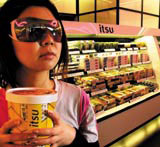Chopsocky moves for fast food
Asian restaurant chains are dishing out a beating to traditional players by offering interiors that are as fresh as the food.

London, lunchtime and I’m off. Quick-lickety split, out of the office, pounding the streets, trying to find a hunger fix. The high street throws up the usual suspects; a slightly beaten-up looking Benjys, Pret A Manger with all its New York razzmatazz, British stalwarts M&S and Boots the Chemists, a clutchful of Italian branded coffee chains and, of course, those signature golden arches.
Yet, give it five years and things could be looking very different, as fast food Asian chains continue to spawn across the UK, dishing up not only alternative lunchtime snacks to consumers, but quirky spaces in which to dine.
These restaurants are designed with eclecticism in mind and eschew the cookie-cutter mould churned out by their contemporaries, articulating forms that are the very antithesis to a ‘chain.’ Needless to say, the opportunities for designers and inventive, anarchic blueprints are immense.
Itsu, the six-strong Asian food chain owned by Pret A Manger duo Clive Schlee and Julian Metcalfe, is poised to embark on an ambitious roll-out that could see the company, with its girly butterfly logo, appear on every high street corner, just as Pret did over the past decade.
Afroditi Krassa, creative director of Industrial Design Consultants, was drafted in last year to help take the company forward and is overseeing the development of the brand, art directing packaging, food and interiors. The idea is to create takeaway joints with seating, a concept that moves away from Itsu’s traditional positioning as a restaurant.
The first of potentially hundreds of cafés opened in Vogue House on London’s Hanover Square three months ago. The aim is to open four more before the end of this year, including an Itsu on London’s Piccadilly in a stunning Grade II-listed building in September.
The 210m2 site will be open until 10pm and will have a lighting system that can deftly adjust to day and night time. The food and drinks menu will also change accordingly and the space, with its high ceilings, will have a relaxed, softer feel, like a bar.
Krassa stresses the importance of not becoming a formulaic chain. ‘We will keep elements of Vogue House [for Piccadilly], but design changes to reflect a space, to keep it fresh, different and relevant to the location, otherwise it becomes boring,’ she says.
Krassa wants the Itsu chain to bring the esoteric Japanese style – with all its ‘visual dirt’ – to London.
‘I recently went to Tokyo. It is very fast moving and we wanted to convey this and create a space that is like being in the centre of Tokyo. We are using crazy colours, neons, a kitschiness, like Hello Kitty,’ she explains.
Yo! Sushi is also creating bespoke interiors for its next generation of restaurants. The company, backed by private equity group Primary Capital, is rolling out an ‘aggressive expansion plan’, which will more than double its global arm of sites from eight to 20 and grow the UK portfolio from 19 to 30 sites by 2007.
‘There is no canteen formula, each restaurant is very different. We are constantly moving forward and looking at innovative design ideas – it is a rock ‘n’ roll style, with a big wow factor,’ says Georgia Hall, head of marketing at Yo! Sushi.
For example, the most recent restaurant to open, located just off Oxford Street, features an outside dining area and iPod ‘docking pods’ – both firsts for Yo! Sushi.
Other future potential designs include: touch-screens where you can directly order hot food, the roll-out of plasma screens showing the company’s branded Yo! TV and possibly even a restaurant minus the iconic Yo! Sushi conveyor belt.
Hall also does not rule out launching a Yo! Dim Sum. ‘It is a strong thought and has been talked about,’ she adds.
Yo! Sushi works with Philip Watts Design, Priestman Goode and Ewan Dryburgh Gillian Associates on its interiors. Each project has a three-month lead-time.
The next Yo! Sushi opens in Brighton. It will feature a parked ice cream van from which consumers can pick up takeaway Yo! To Go packs and seating booths with LED-lit beer buckets and call prompts.
‘There is a lot of chaotic inspiration from Japan; it’s a real melting pot and mish-mash. The restaurant is slightly gay and graffiti-esque. Takeaway is a big thing and we will be creating a grab-and-go event using the ice cream van,’ says Philip Watts, founder of Philip Watts Design.
Yo! Sushi is also relaunching its Yo! To Go range for the first time in three years to meet consumers hungry demand for the healthy, fast-food snacks (see News, page 6).
Kurt Zdesar of Nobu notoriety runs Ping Pong, London’s upmarket dim sum restaurant located on Great Marlborough Street and designed by architect David Marquardt and designer Niclas Sellebraten (DW 5 May). Zdesar has ambitious plans to open 20 similar restaurants over five years. The next Ping Pong will be located in Notting Hill.
‘I wanted to bring dim sum up to date and move away from the dragons, red chintz and gold to create a contemporary environment – a lot of thought has gone into the designs,’ he adds.
While the food served in these establishments may be throwaway, the interior designs are anything but. This new breed of bespoke ‘chains’ is creating a welcome splash of exoticism in an otherwise identikit landscape.
Chopstick it to ’em
Yo! Sushi – Soho flagship launched in 1997 with ‘robot’ waiters. £16m turnover.
Itsu – Owned by Julian Metcalfe, Pret A Manger creative director and Clive Schlee, Pret chief executive. Launched first restaurant in Chelsea, 1997.
Ping Pong – founded in May by Kurt Zdesar, former manager of Nobu. It serves a ‘modern take on traditional Chinese dim sum’.
-
Post a comment




